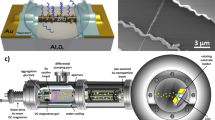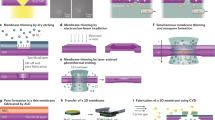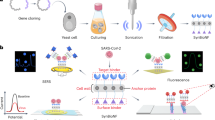Abstract
Semiconducting nanowires have the potential to function as highly sensitive and selective sensors for the label-free detection of low concentrations of pathogenic microorganisms1,2,3,4,5,6,7,8,9,10. Successful solution-phase nanowire sensing has been demonstrated for ions3, small molecules4, proteins5,6, DNA7 and viruses8; however, ‘bottom-up’ nanowires (or similarly configured carbon nanotubes11) used for these demonstrations require hybrid fabrication schemes12,13, which result in severe integration issues that have hindered widespread application. Alternative ‘top-down’ fabrication methods of nanowire-like devices9,10,14,15,16,17 produce disappointing performance because of process-induced material and device degradation. Here we report an approach that uses complementary metal oxide semiconductor (CMOS) field effect transistor compatible technology and hence demonstrate the specific label-free detection of below 100 femtomolar concentrations of antibodies as well as real-time monitoring of the cellular immune response. This approach eliminates the need for hybrid methods and enables system-scale integration of these sensors with signal processing and information systems. Additionally, the ability to monitor antibody binding and sense the cellular immune response in real time with readily available technology should facilitate widespread diagnostic applications.
This is a preview of subscription content, access via your institution
Access options
Subscribe to this journal
Receive 51 print issues and online access
$199.00 per year
only $3.90 per issue
Buy this article
- Purchase on Springer Link
- Instant access to full article PDF
Prices may be subject to local taxes which are calculated during checkout




Similar content being viewed by others
References
Lim, D. V., Simpson, J. M., Kearns, E. A. & Kramer, M. F. Current and developing technologies for monitoring agents of bioterrorism and biowarfare. Clin. Microbiol. Rev. 18, 583–607 (2005)
Madou, M. J. & Cubicciotti, R. Scaling issues in chemical and biological sensors. Proc. IEEE 91, 830–838 (2003)
Cui, Y., Wei, Q., Park, H. & Lieber, C. M. Nanowire nanosensors for highly sensitivie and selective detection of biological and chemical species. Science 293, 1289–1292 (2001)
Wang, W. U., Chen, C., Lin, K.-h., Fang, Y. & Lieber, C. M. Label-free detection of small-molecule-protein interactions by using nanowire nanosensors. Proc. Natl Acad. Sci. USA 102, 3208–3212 (2005)
Tang, T. et al. Complementary response of In2O3 nanowires and carbon nanotubes to low-density lipoprotein chemical gating. Appl. Phys. Lett. 86, 103903 (2005)
Zheng, G., Patolsky, F., Cui, Y., Wang, W. U. & Lieber, C. M. Multiplexed electrical detection of cancer markers with nanowire sensor arrays. Nature Biotechnol. 23, 1294–1301 (2005)
Hahm, J.-i. & Lieber, C. M. Direct ultrasensitivie electrical detection of DNA and DNA sequence variations using nanowire nanosensors. Nano Lett. 4, 51–54 (2004)
Patolsky, F. et al. Electrical detection of single viruses. Proc. Natl Acad. Sci. USA 101, 14017–14022 (2004)
Cheng, M. M.-C. et al. Nanotechnologies for biomolecular detection and medical diagnostics. Curr. Opin. Chem. Biol. 10, 11–19 (2006)
Li, Z. et al. Sequence-specific label-free DNA sensors based on silicon nanowires. Nano Lett. 4, 245–247 (2004)
Chen, R. J. et al. An investigation of the mechanisms of electronic sensing of protein adsorption on carbon nanotube devices. J. Am. Chem. Soc. 126, 1563–1568 (2004)
Huang, Y., Duan, X., Wei, Q. & Lieber, C. M. Directed assembly of one-dimensional nanostructures into functional networks. Science 291, 630–633 (2001)
Evoy, S. et al. Dielectrophoretic assembly and integration of nanowire devices with functional CMOS operating circuitry. Microelect. Eng. 75, 31–42 (2004)
Englander, O., Christensen, D., Kim, J., Lin, L. & Morris, S. J. S. Electric-field assisted growth and self-assembly of intrinsic silicon nanowires. Nano Lett. 5, 705–708 (2005)
Elibol, O. H., Morisette, D., Akin, D., Denton, J. P. & Bashir, R. Integrated nanoscale silicon sensors using top-down fabrication. Appl. Phys. Lett. 83, 4613–4615 (2003)
Clement, N. et al. Electronic transport properties of single-crystal silicon nanowires fabricated using an atomic force microscope. Physica E 13, 999–1002 (2002)
Wang, D., Sheriff, B. A. & Heath, J. R. Silicon p-FETs from ultrahigh density nanowire arrays. Nano Lett. 6, 1096–1100 (2006)
Liu, Y., Ishii, K., Tsutsumi, T., Masahara, M. & Suzuki, E. Ideal rectangular cross-section Si-fin channel double-gate MOSFETs fabricated using orientation-dependent wet etching. IEEE Elect. Dev. Lett. 24, 484–486 (2003)
Saitoh, M., Murakami, T. & Hiramoto, T. Large Coulomb blockade oscillations at room temperature in ultranarrow wire channel MOSFETs formed by slight oxidation process. IEEE Trans. Nanotech. 2, 241–245 (2003)
Tabata, O., Asahi, R., Funabashi, H., Shimaoka, K. & Sugiyama, S. Anisotropic etching of silicon in TMAH solutions. Sensors Actuators A 34, 51–57 (1992)
Bunimovich, Y. L. et al. Electrochemically programmed, spatially selective biofunctionalization of silicon wires. Langmuir 20, 10630–10638 (2004)
Sze, S. M. Physics of Semiconductor Devices 2nd edn 849 (John Wiley & Sons, New York, 1981)
Sun, S. C. & Plummer, J. D. Electron mobility in inversion and accumulation layers on thermally oxidized silicon surfaces. IEEE J. Solid-State Circuits 15, 562–573 (1980)
Sheehan, P. E. & Whitman, L. J. Detection limits for nanoscale biosensors. Nano Lett. 5, 803–807 (2005)
Laws, G. M. et al. Molecular control of the drain current in a buried channel MOSFET. Phys. Status Solidi B 233, 83–89 (2002)
Trautmann, A. Microclusters initiate and sustain T cell signaling. Nature Immunol. 6, 1213–1214 (2005)
Beeson, C. et al. Early biochemical signals arise from low affinity TCR-ligand reaction at the cell-cell interface. J. Exp. Med. 184, 777–782 (1996)
Strother, T., Hamers, R. J. & Smith, L. M. Covalent attachment of oligodeoxyribonucleotides to amine-modified Si (001) surfaces. Nucleic Acids Res. 28, 3535–3541 (2000)
Israelachvili, J. N. Intermolecular and Surface Forces with Applications to Colloidal and Biological Systems Ch. 12 (Academic Press, New York, 1985)
Hermanson, G. T. Bioconjugate Techniques Ch. 1–3, 5, 7 8 (Elsevier Science & Technology Books, New York, 1996)
Acknowledgements
We thank R. Ilic, D. Westly, M. Metzler and V. Genova (Cornell Nanofabrication Facility) for device processing assistance; T. Ma, R. Sleight, J. Hyland, M. Young and C. Tillinghast for device processing discussions; F. Sigworth and D. Stern for functionalization and sensing discussions and for assistance in manuscript preparation; M. Saltzman, K. Klemic, A. Flyer, J. Bertram and S. Jay for functionalization and sensing discussions; Z. Jiang for scanning electron micrograph imaging assistance; S. R. Lee for Silvaco simulations; and R. Munden for device measurement assistance. This work was partially supported by DARPA through ONR and AFOSR (M.A.R.), NASA (M.A.R.), the NIH (A.D.H.), the Coulter Foundation (T.M.F.), by a Department of Homeland Security graduate fellowship (E.S.), and by a N.S.F. graduate fellowship (E.S., D.A.R.). This work was performed in part at the Cornell Nanoscale Science and Technology Facility, a member of the National Nanotechnology Infrastructure Network that is supported by the NSF.
Author Contributions E.S. performed device fabrication and measurements. J.F.K. assisted in fabrication design, D.A.R. performed device mobility experiments and analysis, and P.N.W. and A.D.H. provided molecules used for device functionalization. D.T-E. assisted in device characterization. E.S. and T.M.F. performed T-cell isolation and T-cell measurements. D.A.L., T.M.F. and M.A.R. contributed to experimental design, characterization and interpretation. E.S., J.F.K., T.M.F. and M.A.R. analysed the data and wrote the manuscript with contributions from all authors.
Author information
Authors and Affiliations
Corresponding authors
Ethics declarations
Competing interests
Reprints and permissions information is available at www.nature.com/reprints. The authors declare no competing financial interests.
Supplementary information
Supplementary Notes
This file contains Supplementary Notes describing the device fabrication, functionalization, and sensing as well as accumulation-mode DNA sensing and inversion-mode functionalized and unfunctionalized sensing. The document contains Supplementary Figures 1-8, Supplementary Tables 1-2 and additional references. (PDF 677 kb)
Rights and permissions
About this article
Cite this article
Stern, E., Klemic, J., Routenberg, D. et al. Label-free immunodetection with CMOS-compatible semiconducting nanowires. Nature 445, 519–522 (2007). https://doi.org/10.1038/nature05498
Received:
Accepted:
Issue Date:
DOI: https://doi.org/10.1038/nature05498
This article is cited by
-
Fringe-fields-modulated double-gate tunnel-FET biosensor
Scientific Reports (2024)
-
Alanine aminotransferase assay biosensor platform using silicon nanowire field effect transistors
Communications Engineering (2023)
-
Visualizing single-molecule conformational transition and binding dynamics of intrinsically disordered proteins
Nature Communications (2023)
-
Impact of trap-related non-idealities on the performance of a novel TFET-based biosensor with dual doping-less tunneling junction
Scientific Reports (2023)
-
Gate All Around Dopingless Nanotube TFET Biosensor with Si0.5Ge0.5 – Based Source
Silicon (2022)
Comments
By submitting a comment you agree to abide by our Terms and Community Guidelines. If you find something abusive or that does not comply with our terms or guidelines please flag it as inappropriate.



